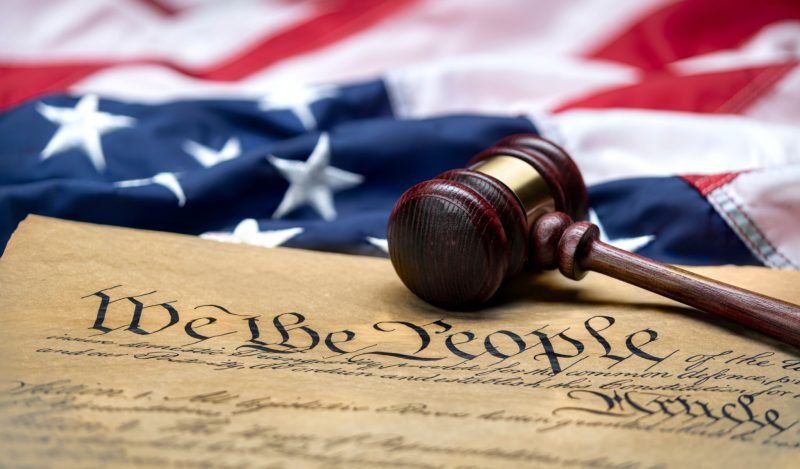Silicon Valley Bank is headquartered just 15 miles down the road from Stanford Law, yet students held no protests last week to object to the bailout of the tech financiers. The highly paid professionals in Stanford’s “equity” office made no statements concerning the transfer of public funds to the bankers behind America’s richest sector.
As Craig Pirrong wrote in Brownstone, there was no “Occupy Silicon Valley” or rage against the “politically tainted response that will have baleful consequences in the future.” Instead, students and administrators focused their attention on attacking a federal judge for having the wrong political affiliation.
Campus censorship struck again last week when hecklers at Stanford Law shouted down Fifth Circuit Judge Stuart Kyle Duncan, who was scheduled to deliver a speech on legal cases surrounding “Covid, Guns, and Twitter.”
Protestors including Tirien Steinbach, Stanford’s associate dean for diversity, inclusion, and equity, emailed students ahead of the event. They accused Judge Duncan of “repeatedly and proudly threaten[ing] healthcare and basic rights for marginalized communities, including LGBTQ+ people, Native Americans, immigrants, prisoners, Black voters, and women.”
The self-appointed censors appeared at the event and screamed to prevent Judge Duncan from delivering his address. According to Ed Whelan at National Review, five law school administrators were present. Instead of informing the hecklers that they were violating the school’s free speech policy or asking them to stop disrupting the event, Stanford officials allowed the censorious chaos to continue.
Amid the cacophony of screams and screeches, DEI Dean Steinbach took the microphone that was prepared for Judge Davis. She delivered six minutes of planned remarks that attacked Davis and the underlying concepts behind free speech. She claimed the Judge “literally denies the humanity of people.” On the issue of free expression, she asked, “Is the juice worth the squeeze?”
Law Professor Josh Blackman responded to Steinbach, “Students attend an elite institution like Stanford to learn firsthand from luminaries like sitting federal judges. How could those comments possibly not be worth Duncan’s presence on campus?”
Students were never permitted to hear Duncan’s remarks. Federal marshals escorted him out the back door when hostilities continued after Steinbach’s sanctimonious diatribe.
“Don’t feel sorry for me,” Duncan told The Washington Free Beacon. “I’m a life-tenured federal judge. What outrages me is that these kids are being treated like dogs**t by fellow students and administrators.”
Stanford attracted significant media attention for its failure to protect campus speech, but the law school is not alone in its apparent preference for promoting socially fashionable political points over the right to free expression.
Last Among Equals
On Monday, The New York Times reported on Penn Law’s current conflict with Professor Amy Wax. Like Duncan’s hecklers, Wax’s opponents accuse her of the familiar parade of horribles: xenophobia, sexism, racism, and more. Penn Law is now considering whether it can fire Wax despite her tenured status with the school.
Theodore Ruger, Dean of Penn Law, has filed a complaint and requested a hearing to consider imposing “major sanctions” on Wax. Ty Parks, the advocacy chair for Penn’s Black Law Students Association, told The Times that Wax’s employment contradicts the school’s commitment to “inclusion.”
Wax responded that universities want to “banish and punish” anyone “who dares to dissent, who dares to expose students to different ideas.” Those calling for her to be fired object to her past statements on immigration, cultural differences, and affirmative action.
The day after the NYT piece, Brownstone published “The Corruption of Georgetown Law,” which focused on GULC’s recent controversies involving free speech. A few examples include the school’s suspension of Ilya Shapiro for a tweet criticizing President Biden’s decision to limit his Supreme Court considerations to black women, its termination of Sandra Sellers for noticing racial disparities, and its decision to suspend me and force me to undergo psychiatric evaluations for questioning their Covid policies.
The three cases are not identical: Wax has a more notable history of controversial statements than Judge Duncan; Georgetown’s failures to defend free expression appear more systematic than Penn’s objection to Wax; Stanford’s DEI dean demonstrated an exceptional disdain for free speech, even for 2023 campus standards. But, in essence, they are each last among equals for distinct reasons.
At their core, there is a common thread of students and administrators attacking dissidents who pose threats to university-sanctioned groupthink.
A Long Way from 1964
As opposed to fifty years ago, today’s protesting students do not exhibit an instinctive aversion to authority. With each controversy, they join the country’s most powerful forces in calling for more censorship, fewer civil liberties, and less tolerance for dissenting viewpoints.
The rhetoric of students and administrators is indistinguishable. At Stanford, DEI Dean Steinbach led the students in their heckling and censorship of Judge Davis. At Georgetown, Professor Josh Chafetz justified protestors accosting the homes of Supreme Court Justices “when the mob is right.” At Penn, Dean Theodore Ruger called on the faculty to consider a “major sanction” of Wax before complaining that her past statements were “racist, sexist, xenophobic, and homophobic.”
Compare that to Sabiya Ahamed, a Georgetown Law student who shouted and screeched until the acting secretary of homeland security was forced offstage at Georgetown Law in 2019. Ahamed told The New York Times there was “nothing to debate,” so she appointed herself censor for the campus and prevented her peers from hearing the government official. Or consider Hamsa Fayed, also a Georgetown Law student, who demanded that the school revoke a professor’s right to administer grades in her courses for administering “violently Islamophobic and racist exams.” As proof for his accusation, he offered past exam questions that compared women’s rights in Western nations and Muslim-majority countries.
Steinbach, Ahamed, Ruger, Fayed, and their cohorts are birds of a feather, pursuing the same overarching goals of purging dissent and demanding contrition.
At first glance, students, university administration, and multinational corporations appear to be strange bedfellows. It would be like Mario Savio calling on UC Berkeley to ban unwelcome political organizations or Kent State students marching to defend the legacy of Henry Kissinger.
Georgetown, Stanford, and Penn have a combined endowment of $60 billion. The average debt taken on by students is over $170,000 at Georgetown Law, over $160,000 at Penn Law, and over $150,000 at Stanford Law. Ostensibly, the parties should be in opposition. Instead, there is an inverted mercenary system. Students pay fortunes to attend these schools and promptly attack dissidents, benefitting the institutions that they help enrich.
G.K. Chesteron wrote, “The Special mark of the modern world is not that it is skeptical, but that it is dogmatic without knowing it.” Instead of challenging authority and the nation’s corrupted and centralized power structures, law students on both coasts now rage alongside the machine, attacking individuals for the slightest of heresies. They augment the power of systems that students formerly opposed, eroding the culture of free expression that created the universities they destroy.
Published under a Creative Commons Attribution 4.0 International License
For reprints, please set the canonical link back to the original Brownstone Institute Article and Author.









